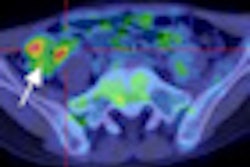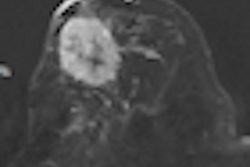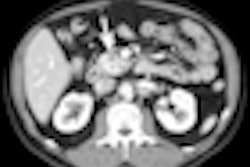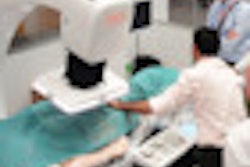VIENNA - Among the firsts in store for this year's 2012 European Congress of Radiology (ECR) will be free, live webcasts of key events, including today's opening session, organizers said in a news conference launching the event. This year's 24th ECR -- the 18th held in Vienna -- is expecting more than 20,000 participants and 300 vendors from more than 90 countries, despite Europe's ongoing economic woes.
Integrated imaging paradigm
"This was the reason why, in 2011, two new European specialty societies were founded under the umbrella of the European Society of Radiology: The European Society of Oncologic Imaging and the European Society of Emergency Radiology," said Professor Lorenzo Bonomo, ECR 2012 president and chair of radiology and bioimaging at Garnelli Hospital in Rome.
The educational program at ECR 2012 includes many new sessions, including New Horizons sessions, the State of the Art symposia, Professional Challenges sessions, three categorical courses, and three new multidisciplinary sessions in breast cancer, pancreatic cancer, and lymphoma. As healthcare and technology continue to evolve, "multidisciplinary interaction is very important, and radiologists play an important role in the multidisciplinary team," Bonomo said.
This year's meeting also renews its commitment to interactivity with more interactive courses designed to bring radiologists and other specialties closer together. The three multidisciplinary sessions this week will bring radiologists together with hematologists, oncologists, pathologists, and surgeons discussing better ways to manage patients with cancer, Bonomo said. A wide array of refresher courses will cater to younger radiologists.
The webcast begins at 5:30 p.m. Vienna time on the ECR website.
European Society of Radiology President András Palkó, chairman of radiology at Szeged University Medical School in Hungary, spoke about radiology's future in a world of integrated diagnostics -- and the emerging notion that radiologists will increasingly play a central role in an integrated healthcare management team.
With today's lightning-fast pace of technological development, the hardest question to answer may be which ones make sense, he said.
For example, MRI for back pain has been found to change management or result in faster healing in very few patients, he said. "On the other hand, if we use CT for patients with acute abdomen, it will result in a 30% decrease in mortality" -- and that's a method that makes sense, Palkó said.
But the most important development today is money. Is the development financeable? "Patients in most parts of the world live longer and better lives, which means that at a given period of time, we have more patients, and these patients have higher expectations," Palkó said. "That results in the situation [where] we have less money and less time per patient. Governments and the health insurance system say there is no more money for healthcare."
To win this game, we have to detect pathological conditions and treat them at a very early stage to delay the onset of symptoms and maybe reduce the severity of disease. On the treatment side, efficiency will require the use of targeted therapies in select patient populations -- and both of those trends call for the increasing use of multidisciplinary teams led in many cases by radiology, Palkó said.
"In this whole process, imaging plays a very important role because imaging, beyond being able to show the structure and function, shows metabolism in vivo in practically all conditions -- thus allowing early disease detection," he said. "It also is able to control therapy by visualizing the delivery of medical treatment, and also to control the results ... of these therapies. And since we are entering an era in which biomarkers are more and more important, imaging will become a tool by which biomarkers describing different conditions may be collected."
The most important potential way to progress is by integrated diagnostics, which means that the results of different modalities and different disciplines will be integrated into a single dataset, allowing doctors to draw conclusions that are both early and accurate, he said. This method contrasts sharply with today's collection of different tests conducted separately by different kinds of physicians, without integration that would allow them to be analyzed together, in most cases.
"This is the kind of one-stop shopping which is not accessible today in practically any of the centers, but this is the way we have to go," Palkó said. The future will bring more intelligent equipment and robots that decrease the role of human influence, and amassed information in larger amounts to increase decision support.
"We have computer-assisted detection today but not computer-assisted diagnosis. It's just a matter of time to reach that stage, and we will have a much shorter and much cheaper way to definitive diagnosis," he said. Radiologists will serve an increasingly vital role as gatekeepers in the integration of this new technology, Palkó added.
ECR poster
In her talk, Dr. Sylvia Ferino-Pagden, from Vienna's Kunsthistorisches Museum, discussed the role of the artist behind this year's ECR poster, Spring by Giuseppe Arcimboldo, a late Renaissance artist from Lombardi who spent many years working in Vienna, painting animals and plants that were incorporated into the premiere scientific books on botany and wildlife of the day.
Dr. Matthew Wallis, a researcher from Cambridge University in Cambridge, U.K., talked about controversies in breast imaging, which will be the subject of a special focus session taking place on Friday at 8:30 a.m. in Room F2 of the Vienna International Center.
While there is general consensus that mammography screening reduces breast cancer mortality -- by about 19% over 25 years -- there is always a cost, both in dollars and to society, for gaining that knowledge, Wallis said. Radiologists need to understand and balance those risks and benefits, as well as explain the different risks to patients.
Overall, one in eight women may develop breast cancer over their lifetimes, he said, but it is a dangerous statistic because it doesn't apply equally to patients who are concerned about contracting the disease, he said. A 30-year-old women complaining of breast pain has an almost negligible risk of breast cancer, while an 85-year-old woman with a lump has about a 50% chance of having breast cancer.
And unfortunately, knowledge is limited as to which cancers are indolent and which are fast growing, because none of them appears threatening when small. That's part of the important work of the future: determining which cancers will grow quickly, and which require less attention, Wallis said.
HIV and imaging
Antiretroviral therapies are changing the face of HIV/AIDS, and HIV in the brain is one of the areas that has seen the greatest advances in imaging, according to Dr. Majda Thurnher, a neuroradiologist who spoke at the press conference in advance of her session on how to image HIV.
Radiologists are seeing new conditions in the brain, as well, including immune reconstitution inflammatory syndrome (IRIS), which occurs when restored immunity following antiretroviral therapy initially causes an abnormally robust response to antigens associated with HIV. But the development of IRIS is "a good prognostic sign," she said. Functional MRI is showing different areas of brain activation in normal versus HIV-infected patients "to compensate for HIV damage," she said of another emerging development.
But it's not all good news, according to Thurnher. Doctors are learning that HIV attacks the brain early after infection with a "smart virus" that cannot be eliminated and probably continues to harm the brain even in the course of successful antiretroviral therapy.
"Are we controlling HIV in the brain, which would be our goal?" she said. "Not really. HIV enters the brain very early and stays there. HIV infection accelerates aging, and antiretroviral therapy, as good as it is, will maybe not completely stop brain damage, so we will certainly have to keep looking at alternatives. HIV was never only about science. It was also always about social justice."



















